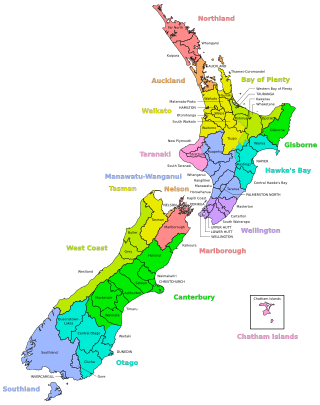Top Qs
Timeline
Chat
Perspective
1989 New Zealand local government reforms
Law in New Zealand From Wikipedia, the free encyclopedia
Remove ads
The 1989 New Zealand local government reform was the most significant reform of local government in New Zealand in over a century. Some 850 local bodies were amalgamated into 86 local authorities, on regional and territorial levels. The new authorities were established on 1 November, following the election of members on 14 October 1989.

Remove ads
Background
The previous major local government reform was the replacement of provincial government with elected borough and county councils at the end of 1876. The Counties Act 1876 created 63 counties out of the rural parts of the provinces.[1]
Over subsequent decades, many new bodies were set up, some of them multi-purpose, and others single-purpose,[2] such as harbour boards. The Local Government Act 1974 consolidated the law relating to territorial local authorities, removing the distinction between urban authorities (boroughs and towns) and rural authorities (counties). It enabled the establishment of regional councils, but these were not established until the 1989 reform.[2]
Remove ads
History
The Labour Party had reform of local government as one of its policies for the 1984 election, but did not give much detail; the proposals were developed during the first term of the Fourth Labour Government after the party won the election.[2] Michael Bassett was Minister of Local Government and appointed a Local Government Commission,[2] which was chaired by Brian Elwood from 1 April 1985 to 1 November 1992.[3][4] The government gave the commission a guarantee that their findings would be treated as binding.[4] The resulting local government reform was undertaken along the lines of marketisation, and was done in conjunction with neoliberal economic reforms known as Rogernomics.[2] Some 850 entities were amalgamated into 86 local authorities on regional and territorial levels.[2] Of the 850 entities, 249 were municipalities,[5] and the remainder harbour boards, catchment boards, and drainage boards. The new authorities came into being on 1 November 1989, with the local politicians having been elected on 14 October.[6] Brian Rudman, a journalist and editorial writer for The New Zealand Herald, called the reforms "revolutionary".[4]
Remove ads
Results of the reform
Summarize
Perspective
Regional authorities
New Zealand was divided into 14 regions, of which 13 were regional authorities, and the remaining one, Gisborne, was a unitary authority. Unitary authorities in New Zealand are district (or city) authorities that also fulfil the function of a regional authority.[7]
Territorial authorities
At a territorial level, district and city authorities were created. The area of a district may belong to more than one regional authority.
Remove ads
References
Wikiwand - on
Seamless Wikipedia browsing. On steroids.
Remove ads
